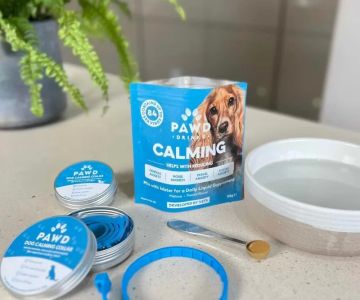How I Discovered the Best Dog Food for Skin Allergies
It was a few years ago when I noticed that my dog, Charlie, began to scratch and bite at his skin more than usual. His fur seemed patchy, and his skin appeared inflamed, red, and irritated. After trying various treatments, I found that the culprit was likely food allergies. I decided to research the best dog food for skin allergies, and it was a journey that led me to discover some amazing products that not only helped Charlie's skin but improved his overall health.

7038 FL-54, New Port Richey, FL 34653, USA
See DetailsThe Link Between Dog Food and Skin Allergies
Many dog owners, like myself, don't realize that food can play a significant role in skin health. Skin allergies in dogs are often a result of food sensitivities or intolerances. When your dog has an allergy to a particular ingredient, their immune system reacts by causing inflammation, itching, and discomfort. This can lead to excessive scratching and licking, which makes the skin conditions worse.
The most common allergens in dog food are proteins like beef, chicken, dairy, and grains like wheat and corn. Once I identified these potential triggers, I started looking for hypoallergenic dog food options that could help Charlie manage his skin allergies.
What to Look for in Dog Food for Skin Allergies
When selecting the right food for dogs with skin allergies, it's essential to choose options that are specifically designed to address food sensitivities. Here’s what I learned during my search:
- Single Animal Protein Source: Many foods for dogs with skin allergies contain a single animal protein, like lamb, turkey, or duck. These proteins are less likely to cause allergic reactions compared to more common proteins like chicken or beef.
- Grain-Free Formulas: Grains such as corn and wheat are common allergens. I found that many hypoallergenic dog foods use sweet potatoes, peas, or other non-grain carbohydrates as their primary source of fiber and energy.
- Limited Ingredients: Some foods are made with limited ingredients to reduce the chances of triggering allergies. This makes it easier for your dog to digest and avoid allergic reactions.
- Omega Fatty Acids: Omega-3 and omega-6 fatty acids are essential for maintaining healthy skin. They can help reduce inflammation and promote a shiny, healthy coat.
Top Dog Foods for Skin Allergies
After trying several brands and formulations, I discovered some excellent dog foods that helped improve Charlie’s skin health. These are the top contenders that I recommend for dogs with skin allergies:
1. Hill’s Prescription Diet z/d
One of the best products I found is Hill’s Prescription Diet z/d. This food is formulated specifically for dogs with food allergies and skin issues. It uses hydrolyzed proteins that are broken down into smaller molecules, making them easier for dogs with sensitivities to digest. Charlie’s skin improved dramatically after switching to this food, and I noticed a significant reduction in his itching and irritation.
2. Royal Canin Veterinary Diet Anallergenic
Royal Canin’s Anallergenic formula is another excellent option for dogs suffering from food allergies. It uses a combination of highly digestible ingredients that help minimize allergic reactions. The formula includes a blend of vitamins and minerals that support overall skin health, helping to keep your dog’s coat looking shiny and healthy.
3. Natural Balance L.I.D. Limited Ingredient Diets
If you’re looking for a more affordable option, I highly recommend Natural Balance L.I.D. Limited Ingredient Diets. This brand offers a variety of limited-ingredient foods that are designed for dogs with food allergies and sensitivities. The potato and duck recipe is a favorite, as it uses simple, high-quality ingredients and is free from grains, soy, and dairy.
4. Wellness Simple Limited Ingredient Diet
Wellness Simple is another great option for dogs with sensitive skin. It uses a single animal protein and a limited number of ingredients to reduce the risk of allergic reactions. The food contains a blend of omega fatty acids to support healthy skin and a shiny coat.
How I Transitioned Charlie to a New Diet
Transitioning your dog to a new diet is crucial to prevent digestive upset. When I started Charlie on his new food, I made sure to gradually mix the new food with his old food over the course of a week. This helped his digestive system adjust to the change. By the end of the week, Charlie was fully on his new diet, and I began to notice improvements in his skin and coat within just a few weeks.
Other Tips for Managing Skin Allergies in Dogs
While switching to the right dog food was a game-changer for Charlie, I also incorporated a few other strategies to help manage his skin allergies:
- Regular Baths: I bathed Charlie with a gentle, hypoallergenic shampoo to help soothe his skin and remove allergens from his coat. I found that regular baths helped reduce irritation and keep his skin hydrated.
- Allergy-Friendly Treats: I made sure the treats I gave Charlie were allergy-friendly, with no grains or common allergens. There are many dog treats available that are made specifically for sensitive pups.
- Consulting a Veterinarian: If your dog’s allergies persist, it’s always a good idea to consult a veterinarian. In some cases, additional treatments, like medications or supplements, may be necessary to keep your dog comfortable.
Final Thoughts on Dog Food for Skin Allergies
Finding the right dog food for skin allergies can be a challenging but rewarding process. It took some trial and error, but once I found the right formula, Charlie’s skin health improved dramatically. If your dog is suffering from skin allergies, I highly recommend starting with hypoallergenic dog food options and making gradual changes to their diet. With the right food and care, your dog’s skin allergies can be managed, and they can enjoy a more comfortable, happy life.











